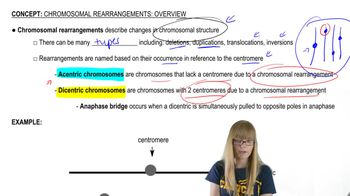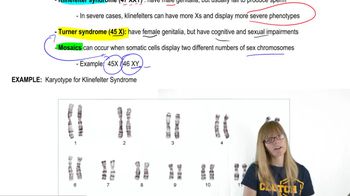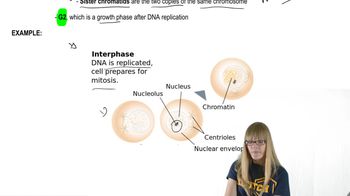Table of contents
- 1. Introduction to Genetics51m
- 2. Mendel's Laws of Inheritance3h 37m
- 3. Extensions to Mendelian Inheritance2h 41m
- 4. Genetic Mapping and Linkage2h 28m
- 5. Genetics of Bacteria and Viruses1h 21m
- 6. Chromosomal Variation1h 48m
- 7. DNA and Chromosome Structure56m
- 8. DNA Replication1h 10m
- 9. Mitosis and Meiosis1h 34m
- 10. Transcription1h 0m
- 11. Translation58m
- 12. Gene Regulation in Prokaryotes1h 19m
- 13. Gene Regulation in Eukaryotes44m
- 14. Genetic Control of Development44m
- 15. Genomes and Genomics1h 50m
- 16. Transposable Elements47m
- 17. Mutation, Repair, and Recombination1h 6m
- 18. Molecular Genetic Tools19m
- 19. Cancer Genetics29m
- 20. Quantitative Genetics1h 26m
- 21. Population Genetics50m
- 22. Evolutionary Genetics29m
9. Mitosis and Meiosis
Mitosis
Problem 7
Textbook Question
How are chromosomes named on the basis of their centromere placement?
 Verified step by step guidance
Verified step by step guidance1
Understand that chromosomes are named based on the position of the centromere, which is the region where the two chromatids are joined.
Learn the four main types of chromosomes based on centromere placement: metacentric, submetacentric, acrocentric, and telocentric.
Metacentric chromosomes have the centromere located in the middle, resulting in two arms of equal length.
Submetacentric chromosomes have the centromere slightly off-center, creating one arm longer than the other.
Acrocentric chromosomes have the centromere near one end, producing a very short arm and a very long arm, while telocentric chromosomes have the centromere at the very end, essentially having only one arm.
Recommended similar problem, with video answer:
 Verified Solution
Verified SolutionThis video solution was recommended by our tutors as helpful for the problem above
Video duration:
2mPlay a video:
Was this helpful?
Key Concepts
Here are the essential concepts you must grasp in order to answer the question correctly.
Chromosome Structure
Chromosomes are thread-like structures made of DNA and proteins, found in the nucleus of eukaryotic cells. Each chromosome consists of two sister chromatids joined at a region called the centromere. The position of the centromere is crucial for chromosome classification and affects the chromosome's shape and behavior during cell division.
Recommended video:
Guided course

Chromosome Structure
Centromere Placement
The centromere is the constricted region of a chromosome that plays a key role in the movement of chromosomes during cell division. Based on the centromere's position, chromosomes can be classified as metacentric (centromere in the middle), submetacentric (centromere slightly off-center), acrocentric (centromere near one end), or telocentric (centromere at the end). This classification helps in identifying and naming chromosomes.
Recommended video:
Guided course

Rearrangement Overview
Karyotyping
Karyotyping is a laboratory technique used to visualize and analyze the number and structure of chromosomes in a cell. By arranging chromosomes based on their size, shape, and centromere position, scientists can identify chromosomal abnormalities and determine the species. This process is essential for genetic studies and diagnosing genetic disorders.
Recommended video:
Guided course

Human Sex Chromosomes
Related Videos
Related Practice





